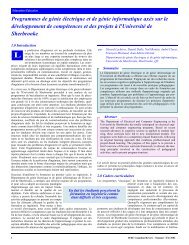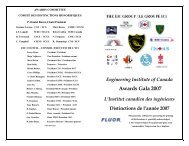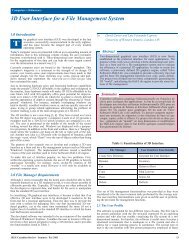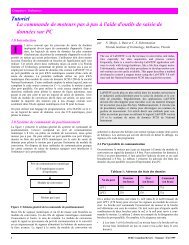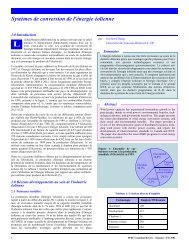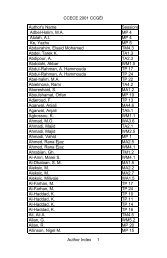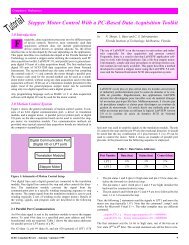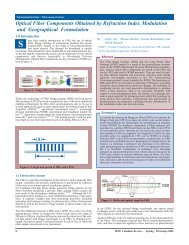CR51-Version 179 - IEEE
CR51-Version 179 - IEEE
CR51-Version 179 - IEEE
- No tags were found...
Create successful ePaper yourself
Turn your PDF publications into a flip-book with our unique Google optimized e-Paper software.
y using (2), given that the product of u and y is always positive and thatby definition the stored energy for this element is zero, so that energy isdissipated at all time, unless u or y equals zero. Henceforth, V-I characteristicof a diode and saturation characteristic of a magnetic circuit(without hysteresis) are examples of memoryless passive componentmodels.For a dynamic model, the phase angle of passive (respectively strictlypassive) linear systems is within [−π/2 rad , π/2 rad] (respectively, (−π/2 rad, π/2 rad) ). A complete set of passivity (positive realness) conditionsis presented in [12]. Hence, the negative feedback of two strictlypassive systems, ∑ 1 and ∑ 2 , has a phase angle less than 180° and is characterizedby an infinite gain margin as shown in Fig 2(c).Relationships between passivity and stability are fundamental results thatare well known in the fields of nonlinear systems [4]. Energy-balanceinequality (2) with dissipation suggests that one expects stability or atleast stabilizability of Σ. From the use of inner product u T y in (2), passivityis naturally geared to the space (L 2 ) of finite energy signals. Moreprecisely, from (2) and condition δ>0, it can be shown that strictly outputpassive systems are bounded-input bounded-output (BIBO) stable in theL 2 space, as illustrated in Figure 2(b). This means that such systems havefinite input-output gains. Furthermore, a connection with the internal stabilityof systems, that is, stability of the states around an equilibrium, canbe established provided some form of observability or detectability ismet [5].Circuit theory can be helpful for the understanding of passivity invarianceresults [13]. For instance, series and parallel connections of passiveelectrical components, such as resistor, capacitor, and inductor, remainpassive. Furthermore, Tellegen’s Theorem [13] implies that a networkmade up of passive N-ports will itself be passive. Equivalent results inmechanics, for instance, can also be found by considering mass, spring,and dashpot. Extension of these facts to nonlinear systems is possible bymeans of the passivity theorem, which states that the feedback connectionof two passive systems is passive [4]-[5]. Several other versionsexist that relate strict passivity to input-output stability. Roughly speaking,these theorems result in the invariance of stability or, at least, stabilizabilityof passive systems that are in a feedback interconnection. Thisproperty is particularly well suited to analyze the behavior of networkedsystems that can be represented as a feedback interconnection of passiveor to-be-passivated subsystems [14].3.0 Passivity and Networked SystemsNetworks of dynamical systems are generally represented as sets of ordinaryor partial differential equations and a matrix H of operators K i thatmodels the interconnection structure of the network. K i is typically usedto model the dynamics between two adjacent subsystems that we indistinctivelycall nodes or agents. For instance, in the context of electricalnetwork, K i can be a function of impedances between a node i and itsadjacent nodes j. The matrix H is often related to the generalizedLaplacian of the graph, [15], that characterizes the relationship betweenneighboring nodes of a network. Adjacency of each node and directednessof edges (i j for directed edge), as illustrated in Figure 3(a), areinformation embedded in H.From the structure of Figure 3(b) and applying the passivity theorem, stabilityof the networked system is obtained if the feedforward-path subsystemis passive and the feedback-path subsystem is strictly passive.Depending on the control system’s degrees-of-freedom, forward-pathFigure 2: Input-output sector and energy propertiesand feedback-path subsystems can be rendered passive, if not already,provided some structural properties of each subsystem is satisfied [5].Figure 3: Graph and closed-loop representationof a network systemPassivity techniques have been recently used to solve stabilization problemof multi-agent systems. For instance, the interpretation of an optimization-basednetwork flow control as a closed-loop system and the useof passivity can be used to prove the stability of a class of network flowregulation, which is typical of internet congestion control [16]. Thisapproach has also been used for the decentralized power control of codedivision multiple access systems. A gradient-based law, which isobtained from a game-theoretical formulation, is shown to converge to aNash equilibrium by means of passivity argument applied to a closedloopmodel that results from the feedback interpretation of an optimizationproblem [17].4.0 Passivity for the Stability Analysis of ElectricalPower SystemsPassivity can be used to analyze power systems stability when the networkedsystem is faced with: (i) voltage disturbance ṽ o located at anobservation point or a connection point o to another subnetwork; (ii) disturbanceṽ cj at a point where the electrical component C j is connectedδto the power grid (Figure 4). In order to work within an input-outputpoint of view, the power system is decomposed by using the component-orientedmodeling technique [18]. By component is meant anelectrical load, a generator or a compensator. Figure 3(b) suggests anobvious closed-loop interpretation for electrical power network, wherethe power grid is represented by an admittance matrix H. Each componentconnected to the network is modeled as a voltage or current sourcein feedback with H as shown in Figure 4. Each component or aggregateof components is supposed to be controllable through channels u vi andu ci . When no perturbation occurs, the system lies in its equilibriumpoint 0 x; when perturbations occur, the system is described witherror signals ˜x =x- 0 x, where x is any current i and voltage v of the network.Assume the power grid can be approximated as a linear time-invariant N-port. To ensure strict passivity of the forward-path subsystem of Figure4, the complex admittance H(jω) has to verify the following strict-positiverealness constraint H(s – ε) + H*(s – ε) ≥ 0 for Re(s) ≥ 0 and someε > 0.It was proven in [19] that a radialpower network whose linesare represented with the T-equivalent model shown for onephase in Figure 1, is strictlyinput passive with only currentsource components. A generalizationto both types of componentsin feedback necessitatesconsidering small parasiticshunt resistances in parallelwith C j .A direct application of passivitytheorem indicates that finiteenergystability is obtained ifeach component or aggregate ofcomponents is passive or has10<strong>IEEE</strong> Canadian Review — Fall / Automne 2005


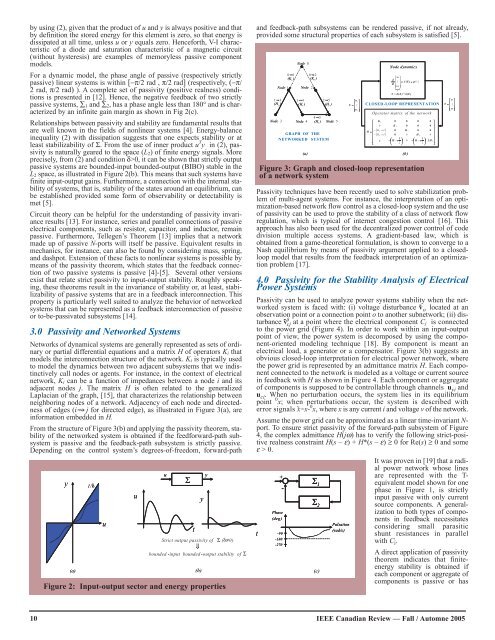
![Download Presentation [1.9MB PDF] - IEEE](https://img.yumpu.com/51364167/1/190x146/download-presentation-19mb-pdf-ieee.jpg?quality=85)

![Download Presentation [950KB PDF] - IEEE](https://img.yumpu.com/50598566/1/190x146/download-presentation-950kb-pdf-ieee.jpg?quality=85)

